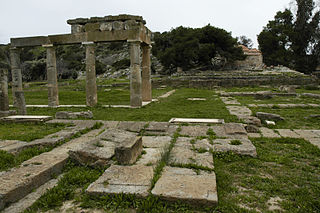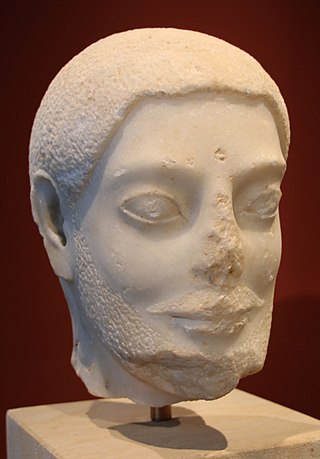An attic is an area under the roof of a house.
Contents
Attic may also refer to:
An attic is an area under the roof of a house.
Attic may also refer to:

Athens is a major coastal urban area in the Mediterranean, and it is both the capital and the largest city of Greece. Athens is also the capital of the Attica region and is the southernmost capital on the European mainland. With its urban area's population numbering over three million, it is also the eighth largest urban area in the European Union. The Municipality of Athens, which constitutes a small administrative unit of the entire urban area, had a population of 643,452 (2021) within its official limits, and a land area of 38.96 km2 (15.04 sq mi).

Marathon is a town in Greece and the site of the Battle of Marathon in 490 BCE, in which the heavily outnumbered Athenian army defeated the Persians. Legend has it that Pheidippides, a Greek herald at the battle, was sent running from Marathon to Athens to announce the victory, which is how the marathon running race was conceived in modern times. Today it is part of East Attica regional unit, in the outskirts of Athens and a popular resort town and center of agriculture.

Elefsina or Eleusis is a suburban city and municipality in Athens metropolitan area. It belongs to West Attica regional unit of Greece. It is located in the Thriasio Plain, at the northernmost end of the Saronic Gulf. North of Elefsina are Mandra and Magoula, while Aspropyrgos is to the northeast.

Attica, or the Attic Peninsula, is a historical region that encompasses the entire Athens metropolitan area, which consists of the city of Athens, the capital of Greece and the core city of the metropolitan area, as well as its surrounding suburban cities and towns. It is a peninsula projecting into the Aegean Sea, bordering on Boeotia to the north and Megaris to the west. The southern tip of the peninsula, known as Laurion, was an important mining region.

In ancient Greece, the moriai were olive trees considered to be the property of the state because of their religious significance.

Pottery, due to its relative durability, comprises a large part of the archaeological record of ancient Greece, and since there is so much of it, it has exerted a disproportionately large influence on our understanding of Greek society. The shards of pots discarded or buried in the 1st millennium BC are still the best guide available to understand the customary life and mind of the ancient Greeks. There were several vessels produced locally for everyday and kitchen use, yet finer pottery from regions such as Attica was imported by other civilizations throughout the Mediterranean, such as the Etruscans in Italy. There were a multitude of specific regional varieties, such as the South Italian ancient Greek pottery.
Decelea, Dekéleia), was a deme and ancient village in northern Attica serving as a trade route connecting Euboea with Athens, Greece. It was situated near the entrance of the eastern pass across Mount Parnes, which leads from the northeastern part of the Athenian plain to Oropus, and from thence both to Tanagra on the one hand, and to Delium and Chalcis on the other. It was situated about 120 stadia from Athens, and the same distance from the frontiers of Boeotia. It was visible from Athens and from its heights the ships entering the harbour of Piraeus were visible as well.
Pyanopsia (Πυανόψια) or Pyanepsia (Πυανέψια) was an ancient Athenian festival held in honor of Apollo in Athens on the 7th day of the month Pyanepsion (October/November). Its name literally means "bean-stewing", in reference to one of the sacred offerings given during this time, and is taken from the Greek words πύανος - pyanos "bean" and ἕψειν - hepsein "to boil".

In classical architecture, the term attic refers to a storey above the cornice of a classical façade. The decoration of the topmost part of a building was particularly important in ancient Greek architecture and this came to be seen as typifying the Attica style, the earliest example known being that of the monument of Thrasyllus in Athens.
Ancient Greek units of measurement varied according to location and epoch. Systems of ancient weights and measures evolved as needs changed; Solon and other lawgivers also reformed them en bloc. Some units of measurement were found to be convenient for trade within the Mediterranean region and these units became increasingly common to different city states. The calibration and use of measuring devices became more sophisticated. By about 500 BC, Athens had a central depository of official weights and measures, the Tholos, where merchants were required to test their measuring devices against official standards.

In Greek mythology, Actaeus, also called Actaeon, was the first king of Attica, according to Pausanias.

Brauron was one of the twelve cities of ancient Attica, but never mentioned as a deme, though it continued to exist down to the latest times. It was situated on or near the eastern coast of Attica, between Steiria and Halae Araphenides, near the river Erasinus. Brauron is celebrated on account of the worship of Artemis Brauronia, in whose honour a festival was celebrated in this place. This site includes the remains of a temple, a stoa, and a theatre, providing insights into the religious practices and social life of ancient Greece. Its significance as a religious and cultural site can be further understood through the exploration of its archeological remains and historical accounts.
The Synoikia was an ancient Greek festival held in Athens commemorating the political unification of Attica. It was also called the Thesean Synoikismos and the Feast of Union, and celebrated Theseus as founder of Athens and the goddess Athena as the city's patron goddess. The festival was celebrated in the month of Hekatombeion on the 16th. A two-day festival, on the 15th and the 16th was held every second year.
Standard Greek may refer to:
In classical antiquity the god Pan was often venerated in caves. In the present these caves are often referred to as the Cave of Pan.
Pandion was the eponymous hero of the Attic tribe Pandionis, which was created as part of the tribal reforms of Cleisthenes at the end of the sixth century BC. He is usually assumed to be one of the two legendary kings of Athens, Pandion I or Pandion II.

The Phrasikleia Kore is an Archaic Greek funerary statue by the artist Aristion of Paros, created between 550 and 540 BCE. It was found carefully buried in the ancient city of Myrrhinous in Attica and excavated in 1972. The exceptional preservation of the statue and the intact nature of the polychromy elements makes the Phrasikleia Kore one of the most important works of Archaic art.
The Aphrodisia festival was an annual festival held in Ancient Greece in honor of the goddess of love and beauty, Aphrodite. It took place in several Ancient Greek towns, but was especially important in Attica and on the island of Cyprus, where Aphrodite was venerated with a magnificent celebration. The festival occurred during the month of Hekatombaion, which modern scholars recognize as starting from the third week in July to the third week of August on the Gregorian calendar. Aphrodite was worshipped in most towns of Cyprus, as well as in Cythera, Sparta, Thebes, Delos, and Elis, and her most ancient temple was at Paphos. Textual sources explicitly mention Aphrodisia festivals in Corinth and in Athens, where the many prostitutes that resided in the city celebrated the festival as a means of worshipping their patron goddess. Though no textual sources expressly mention an Aphrodisia festival in Cythera, Thebes, or Elis, it likely occurred since textual and iconographical sources indicate that Aphrodite Pandemos had a cult following in these areas. The Aphrodisia festival was one of the most important ceremonies in Delos, though not much is known about the details of the celebration. The inscriptions merely indicate that the festival required the purchase of ropes, torches and wood, which were customary expenses of all Delian festivals.

Asty is an ancient Greek word denoting the physical space of a city or town, especially as opposed to the political concept of a polis, which encompassed the entire territory and citizen body of a city-state. A similar distinction exists in Latin between urbs and civitas.

The Sabouroff head is a Late Archaic Greek marble sculpture. It is dated to c. 550–525 BC. This head of a Kouros was named after Peter Alexandrovich Saburov, a collector of ancient Greek sculpture and antiquities. It is 23 centimeters in height. The sculpture is currently located in the Antikensammlung Berlin and allegedly from Attica or Aegina. There are conjectures that it may also have been from Caria in Asia Minor.